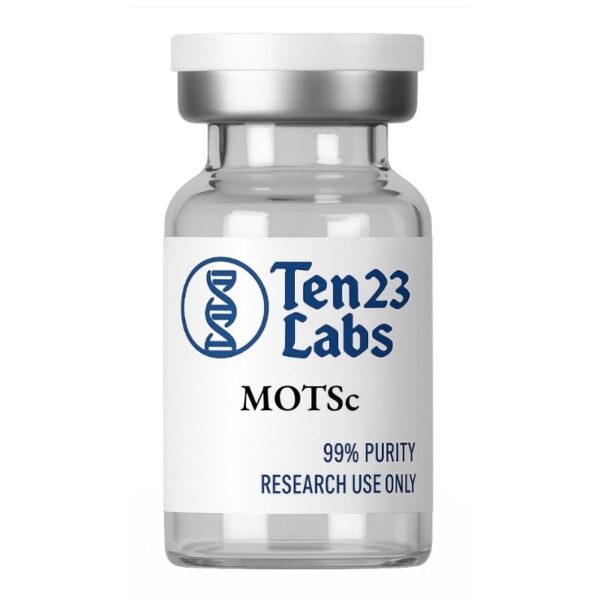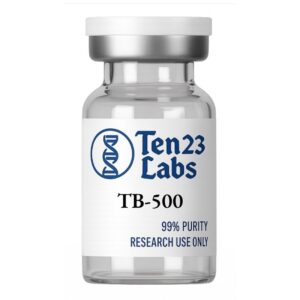🧬 MOTS-c – Research Overview
0. Category:
Metabolic Health, Anti-Aging / Longevity, Muscle Growth / Strength, Inflammation Control, Energy Optimization
1. Primary Research Use:
MOTS-c is primarily researched for its potential to regulate metabolic functions, enhance insulin sensitivity, and promote energy homeostasis. Studies focus on its role in mitigating age-related metabolic decline, improving exercise capacity, and reducing inflammation.
2. Simple Analogy:
Think of MOTS-c as the body’s internal energy coach—guiding cells to efficiently utilize fuel, maintain balance, and perform optimally, much like a coach trains athletes to achieve peak performance.
3. What It Is (Chemical Summary):
MOTS-c is a 16-amino acid peptide encoded by the mitochondrial 12S rRNA gene. It is classified as a mitochondrial-derived peptide (MDP) and is involved in cellular energy regulation and metabolic processes.
4. Best Suited For:
This peptide is commonly researched by those interested in metabolic disorders, age-related diseases, exercise physiology, and inflammatory conditions. It may appeal to researchers studying cellular energy regulation and muscle function.
5. Not Recommended For / Caution In Research With:
Caution is advised when researching MOTS-c in individuals with:
- Pregnancy or breastfeeding (due to insufficient safety data)
- Active cancer (due to potential effects on cell proliferation)
- Autoimmune disorders (as immune modulation effects are not fully understood)
6. Synergistic Peptide Stacks:
- NAD+: May complement MOTS-c by enhancing cellular energy production and promoting longevity pathways.
- AICAR: Often studied together for potential synergistic effects on AMPK activation and metabolic regulation.
- GHK-Cu: Could be combined in research focusing on tissue repair and anti-inflammatory effects.
7. Common Dosing Guidelines (Research Use):
| Common Dosage Range | |
|---|---|
| Beginner | 0.5mg daily |
| Intermediate | 1mg daily |
| Advanced | 3-5mg daily (not common) |
Note: Administration is typically via subcutaneous injection.
8. Cycling Information:
Research protocols often suggest administration for 4–6 weeks, followed by a 2–4 week break. This cycling aims to assess efficacy and monitor for any potential desensitization or side effects.
9. Similar Peptides & Comparison Chart:
| Peptide | Duration | Mechanism of Action | Dosing Frequency | Notes |
|---|---|---|---|---|
| MOTS-c | Short (hours) | Activates AMPK pathway | 2–3x/week | Enhances metabolic flexibility and energy balance |
| AICAR | Short (hours) | AMPK activator | Daily | Mimics exercise-induced metabolic effects |
| GHK-Cu | Medium (hours) | Tissue repair and anti-inflammatory | 1–2x/day | Supports healing and reduces inflammation |
| NAD+ | Short (hours) | Coenzyme in redox reactions | Daily | Supports cellular energy metabolism |
10. Method of Administration:
MOTS-c is typically administered via subcutaneous injection, allowing for systemic absorption and targeted delivery to tissues involved in metabolic regulation.
11. Regulatory Status (FDA Approval):
MOTS-c is not approved by the FDA for any medical or veterinary use. It is classified as an investigational compound and is available for research purposes only. It has not undergone formal clinical trials in the United States.
12. Legal Disclaimer:
All products discussed are intended for laboratory, scientific, and research purposes only. These products are not approved by the FDA for human or veterinary use and are not intended to diagnose, treat, cure, or prevent any disease. They must not be used for any form of medical application or personal use.
The information presented is for educational purposes only and is not medical advice. Always consult a licensed healthcare professional before making decisions regarding your health.
By accessing or purchasing these materials, you affirm that you are a qualified researcher or are acting under the supervision of one. All sales are final.






Reviews
There are no reviews yet.